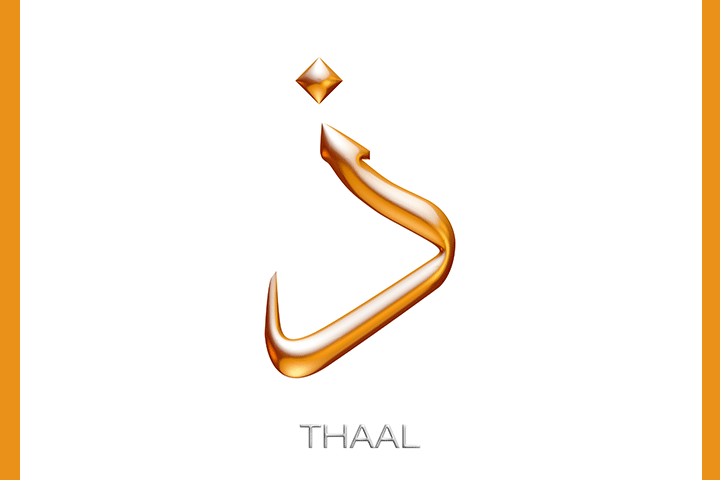Thaal (ذ) is the ninth letter of the Arabic alphabet. It looks very similar to the letter Daal (د), but with one key difference: a single dot above it. The presence of this dot changes the letter’s sound and meaning in a word. Understanding this simple distinction is the first step to mastering it.
Thaal Meaning in English and Pronunciation
The letter Thaal does not have a direct equivalent in English, but its sound is similar to the th in the words “this,” “that,” and “them.”
To pronounce Thaal (ذ) correctly, place the tip of your tongue gently against the back of your top front teeth and let the air flow over it as you make the sound. This is a “voiced” sound, which means your vocal cords should vibrate. A common mistake for many learners is pronouncing it like a z sound.
How to Differentiate Thaal (ذ) from Similar Letters
- Thaal (ذ) vs. Daal (د): The main difference is the sound. Thaal (ذ) is a soft th sound, while Daal (د) is a hard d sound, like in the word “dog.” Visually, Thaal has a dot, and Daal does not.
- Thaal (ذ) vs. Zaay (ز): Thaal (ذ) is a soft th sound (like in “this”) where your tongue is between your teeth. Zaay (ز) is a “z” sound (like in “zebra”), which is made with your tongue on the roof of your mouth.
- Dialect Differences: Be aware that in some Arabic dialects, especially in the Levant, the letter Thaal (ذ) is often pronounced as a Zaay (ز) or Daal (د). While this is common in spoken Arabic, it’s important to learn the correct pronunciation in Modern Standard Arabic.
How to Write the Letter ذ
The letter Thaal is a non-connector, which means it does not connect to the letter that follows it. However, it does connect to the letter that comes before it, if applicable. This results in two main shapes for the letter.
- Isolated / Initial Shape: ذ
- Medial / Final Shape: ـذ
Here are some examples of how to write the letter ذ in different positions:
- Initial: ذَهَبَ (went), ذَكاء (intelligence), ذَقَن (chin), ذيل (tail)
- Middle: أُسْتاذ (teacher), مَذْهَب (sect), حِذاء (shoe), نَافِذَة (window)
- Final: لَذيذ (delicious), قُنْفُذ (hedgehog), تِلمِيذ (student), جُرَذ (rat)
Thaal with the Harakat (الحركات)
The harakat (short vowels) are essential for pronouncing Arabic words correctly. They change the sound of the letter Thaal in different ways:
- ذَ (Thaal with Fatha): Sounds like the th in “that.”
- Examples: ذَهَب (dhahab – gold), ذَكِية (dhakiyah – smart female), ذَوق (dhawq – taste)
- ذُ (Thaal with Damma): Sounds like the th in “thou.”
- Examples: ذُرة (dhurah – corn), ذُبَاب (dhubab – fly), ذُكُور (dhukur – males)
- ذِ (Thaal with Kasra): Sounds like the th in “this.”
- Examples: ذِراع (dhiraa’ – arm), ذِئب (dhi’b – wolf), مَذِيع (madhi’ – announcer)
- ذْ (Thaal with Sukoon): Indicates a resting sound, as in the middle of a word.
- Examples: تِلمِيذ (tilmiidh – student), أُسْتاذ (ustaadh – teacher), مِذياع (midhyaa’ – radio)
Examples with Long Vowels
Long vowels in Arabic are created by adding the letters alif (ا), waw (و), or yaa (ي) after the letter.
- ذا (Thaal + Alif): Sounds like thaa, as in: هذا (haadha – this), مَذاق (madhaaq – taste)
- ذو (Thaal + Waw): Sounds like thoo, as in: ذُو (dhoo – owner of, possessor of),أُذُون (udhün – ears)
- ذي (Thaal + Yaa): Sounds like thee, as in: هَذِي (hadhi – this, feminine), لَذِيذ (ladhiidh – delicious)
Conclusion
Now that you’ve learned about the letter Thaal in Arabic, practice writing it and saying its sound out loud with the examples provided. The more you practice, the more natural it will become. If you’re looking for more ways to learn, check out our other resources you can use the Kaleela app!



